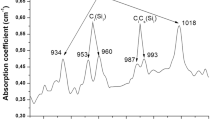Abstract
This paper considers approaches to modeling defects in a semiconductor material using computer calculations, in particular, within the framework of applications that implement density functional theory (DFT). An approach is proposed to study the vacancy mechanism of the mobility of dopant atoms based on the dependence of the binding energy on the impurity fraction. The thermodynamic stability of a semiconductor was studied using the cubic phase of silicon carbide 3C-SiC as an example.




Similar content being viewed by others
REFERENCES
R. O. Jones, “Density functional theory: Its origins, rise to prominence, and future,” Rev. Mod. Phys. 87, 897–923 (2015).
G. Cicero, “Towards SiC surface functionalization: an ab initio study,” J. Chem. Phys. 122, 214716 (2005).
M. Jiang et al., “Ab initio molecular dynamics simulation of the effects of stacking faults on the radiation response of 3C-SiC,” Sci. Rep. 6, 20669 (2005).
Y. S. Ardakani and M. Moradi, “Electronic and optical properties of Te-doped GaN monolayer before and after adsorption of dimethylmercury, DFT+U/TDDFT and DFT-D2 methods,” J. Mol. Graphics Model. 104, 107837 (2021).
N. Liu, et al., “Superconductivity in nitrogen-doped 3C-SiC from first-principles calculations,” Mod. Phys. Lett. B 31, 1750116 (2017).
Y. Gong et al., “Temperature dependence of the Gibbs energy of vacancy formation of fcc Ni,” Mod. Phys. Rev. B 97, 214106 (2017).
H. Jonsson, G. Mills, and K. W. Jacobsen, “Classical and quantum dynamics in condensed phase simulations,” in Proceedings of the International School of Physics, LERICI, Villa Marigola, 1997, pp. 385–404.
D. Sheppard et al., “A generalized solid-state nudged elastic band method,” J. Chem. Phys. 136, 074103 (2012).
Z. Zhang et al., “Interaction of dislocations and interfaces in crystalline heterostructures: a review of atomistic studies,” Crystals 9, 584 (2019).
M. Prelas et al., Nuclear Batteries and Radioisotopes (Springer Int. Publ., 2016).
V. G. Baru and V. V. Vol’kenshtein, Effect of Irradiation on the Surface Properties of Semiconductors (Nauka, Moscow, 1978) [in Russian].
V. S. Vavilov, A. E. Kiv, and O. R. Niyazova, Mechanisms of Formation and Migration of Defects in Semiconductors (Nauka, Moscow, 1981) [in Russian].
M. Blockstedte, A. Mattausch, and O. Pankratov, “Ab initio study of the migration of intrinsic defects in3C-SiC,” Phys. Rev. B 68, 205201-1–205201-17 (2003). arXiv:cond-mat/0309704v1.
A. V. Gurskaya, M. V. Dolgopolov, and V. I. Chepurnov, “C-14 beta converter,” Phys. Part. Nucl. 48, 914—944 (2017).
A. V. Gurskaya, V. I. Chepurnov, M. V. Dolgopolov, and N. V. Latukhina, RF Patent No. 2653398 (2018).
G. Kresse and G. Furthmüller, “Efficient iterative schemes for ab initio total-energy calculations using a plane-wave basis set,” Phys. Rev. B 54, 11169 (1996).
ACKNOWLEDGMENTS
A.V. Gurskaya expresses gratitude to the Ministry of Science and Higher Education for a grant provided by the president of the Russian Federation.
Author information
Authors and Affiliations
Corresponding authors
Ethics declarations
The authors declare that they have no conflicts of interest.
Rights and permissions
About this article
Cite this article
Gurskaya, A.V., Dolgopolov, M.V., Elisov, M.V. et al. Radiation Defect Formation in a Silicon Carbide Betaconverter. Phys. Part. Nuclei Lett. 20, 1094–1097 (2023). https://doi.org/10.1134/S1547477123050345
Received:
Revised:
Accepted:
Published:
Issue Date:
DOI: https://doi.org/10.1134/S1547477123050345




